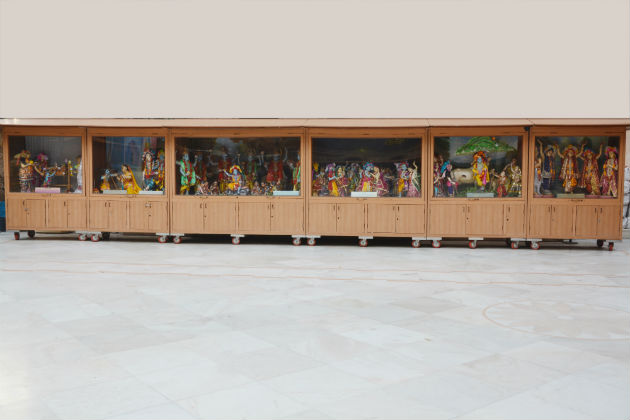Welcome to Our temple tour!
Below is a virtual tour of our temple. Just click on the heading to view a snapshot and description.
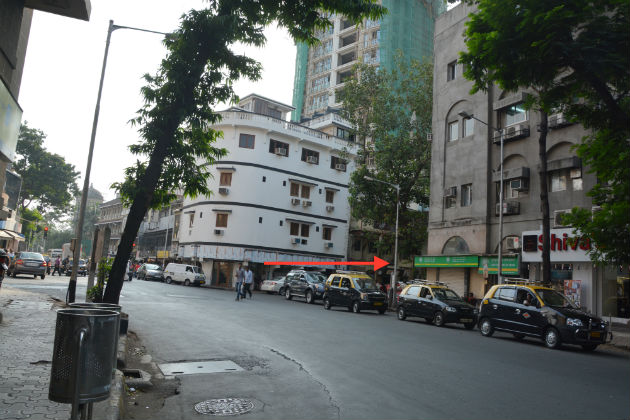
Coming from grant road station. Turn right onto Munshi Marg.
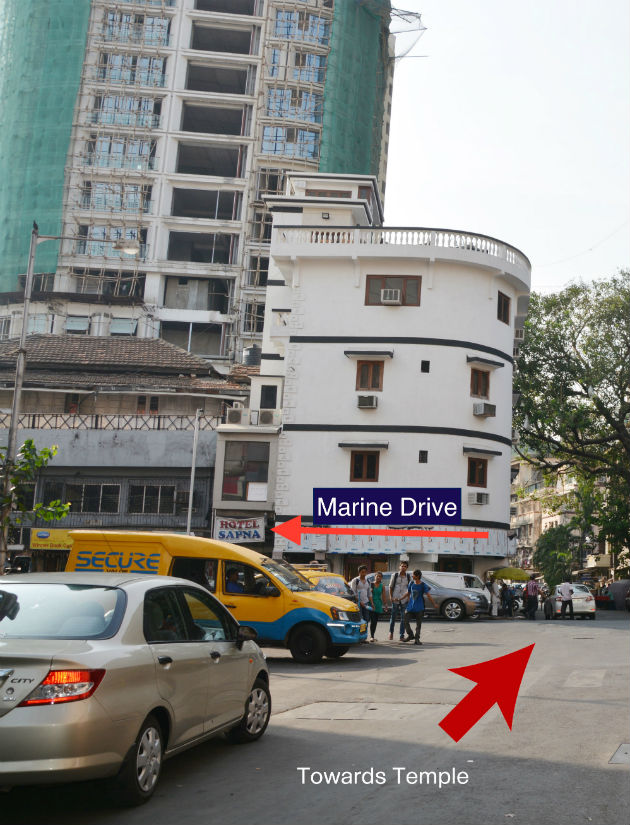
Go straight on Munshi Marg. Bharatiya Vidya Bhavan on right.
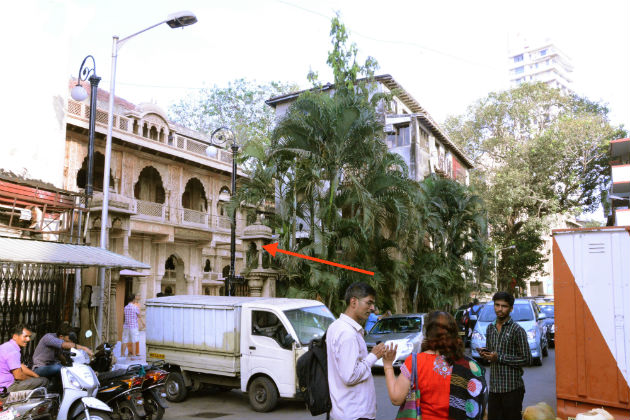
Temple on the left, behind the trees.
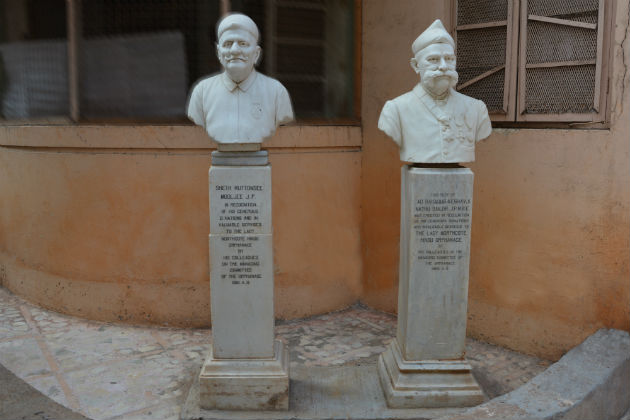
Seth Sri Ruttensey Mulji and a few of his friends established LNHO in 1905. Named after Lady Northcote (wife of Lord Northcote, the then-governor of Mumbai), it sheltered children who had been orphaned by the Bubonic plague that began around 1896 in Mumbai. On Feb 16th 1985 Chandrasen Bhatia (3rd generation descendent of Ruttensey Mulji) passed away, making Dr Desai the managing trustee of LNHO. At this time we joined them. As time went by the LNHO gradually expanded to occupy the whole center building and a few flats (apartments) in adjacent buildings. Then the renovations really began.
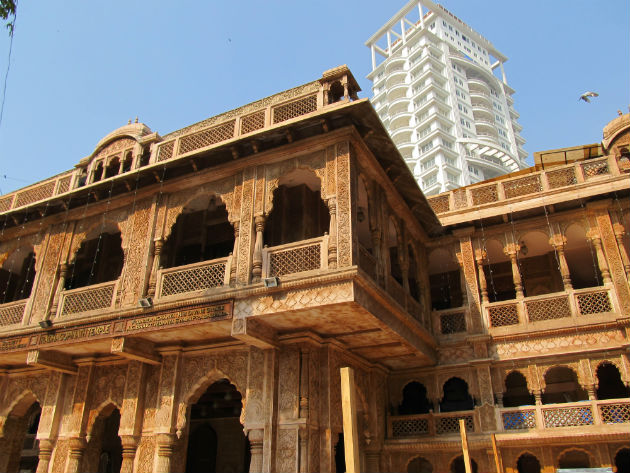
The building is modeled after 17 temples of Vrindavan, which were built by wealthy landlords and kings from Rajasthan. Vasudev was the contractor, coming from a Sampura family (who specializes in temple architecture). The stone is sandstone from Bharatpur Rajasthan. The artisans were from Orissa, and the carving of the stone was done in Pattan Gujarat using neumatic (air pressure) drills. This is one of the main themes at our temple: people from all castes and backgrounds are cooperatively using their talents to serve God. Vasudev mostly built Jain temples during his life. Designing a Krishna temple was a dream for him come true. His work, practically free of cost, went from 1999 – 2004. It is the only Krishna temple with such architecture in South Mumbai.
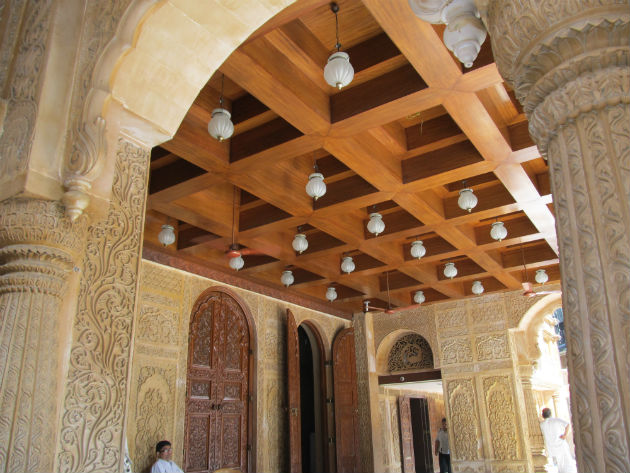
Ceiling outside Bhaktivedanta Hall.
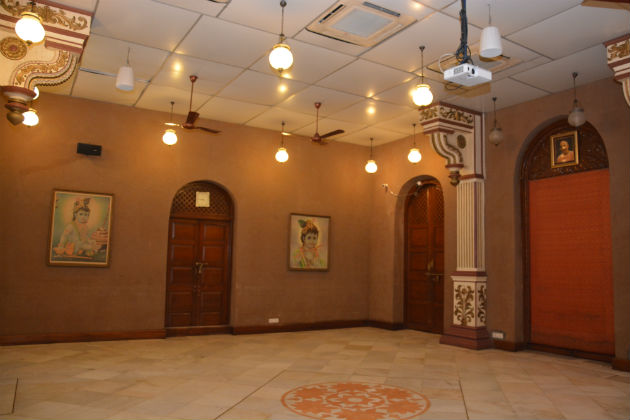
This Hall is used for weddings, seminars, lectures, banquets, parties, and meetings. Originally the walls and ceiling were of wood paneling. But over the years the wood became infested with termites. Everything was gutted, and replaced with eco-friendly materials (a mixture of clay and cow products) that repels insects. Air-conditioned of course!
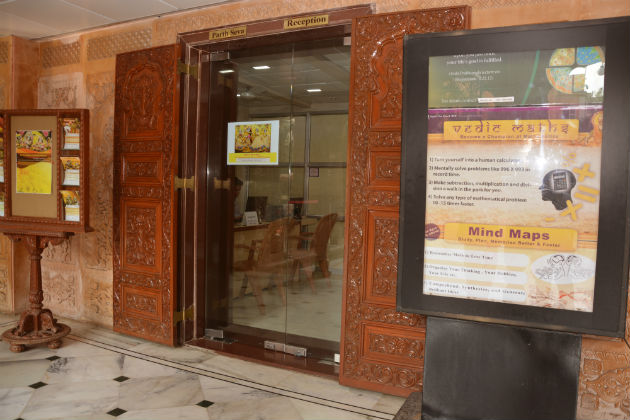
The people sitting here can give more information about the temple and related projects.
There are also people sitting upstairs in the temple room at the entrance, should you have any questions.
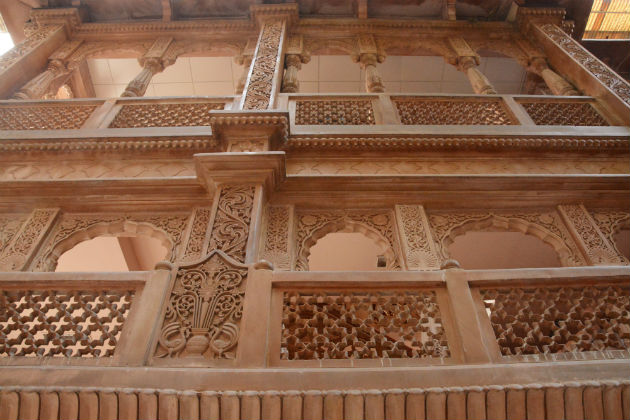
The stairs up to the temple room are below here.
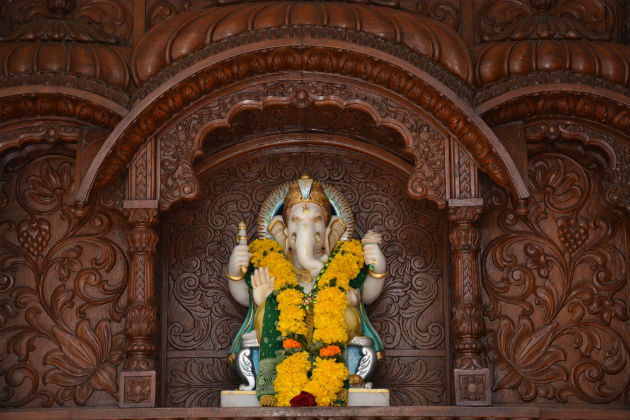
Son of Siva, whose severed head was replaced with that of an elephant. Bestows blessings of wealth and removes obstacles in obtaining knowledge.
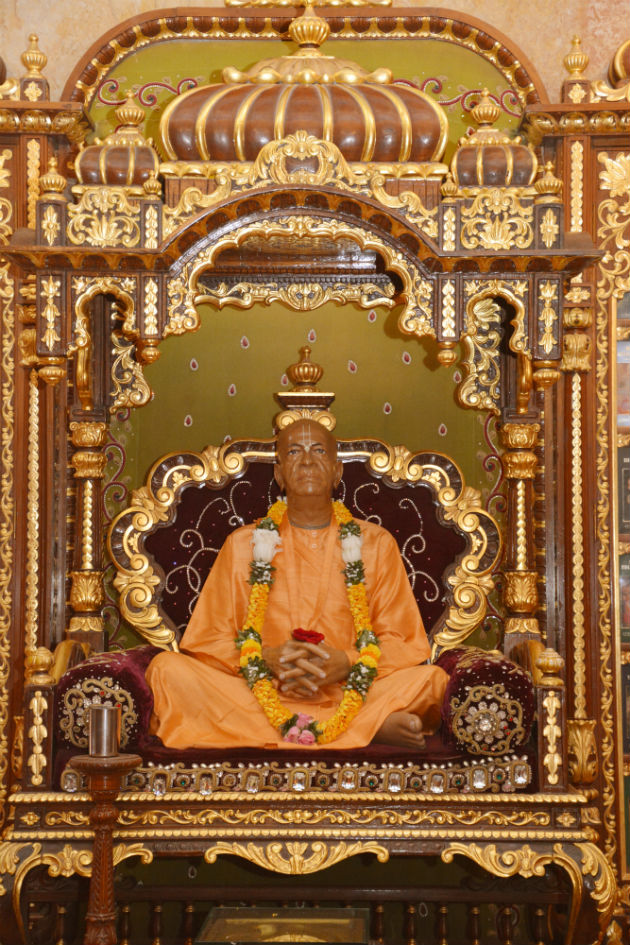
The founder acharya of the temple, Srila Prabhupada (in murti/statue form) is sitting as you enter, on the left.
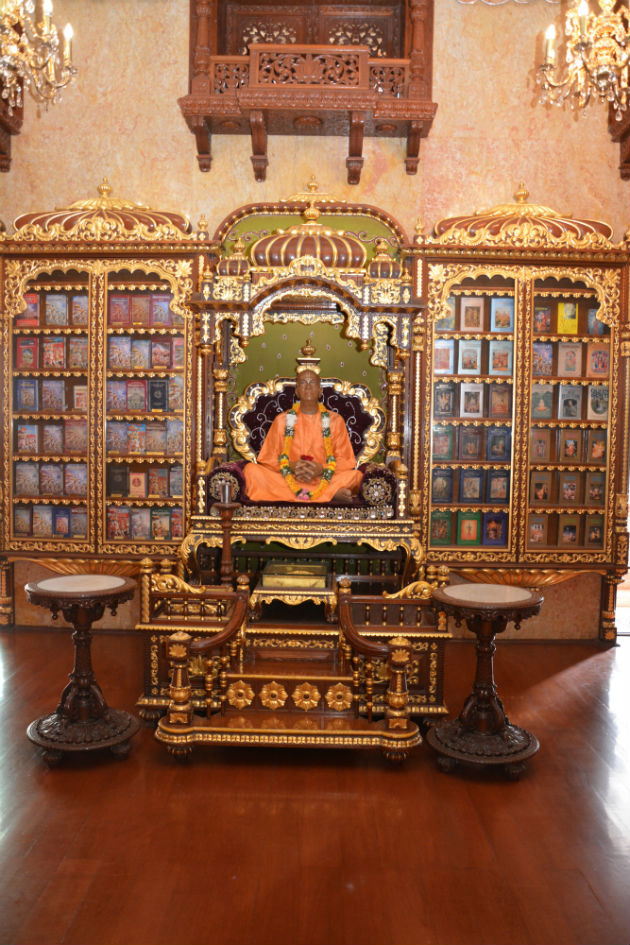
He brought Vedic (ancient Indian) Culture to the whole world by transplanting it first to North America in 1965 and then circled the globe 14 times, dropping seeds wherever he went. In 12 years he established 108 ashrams or temples, translated over 60 books with commentary, accepted students, and started many projects for the benefit of society.
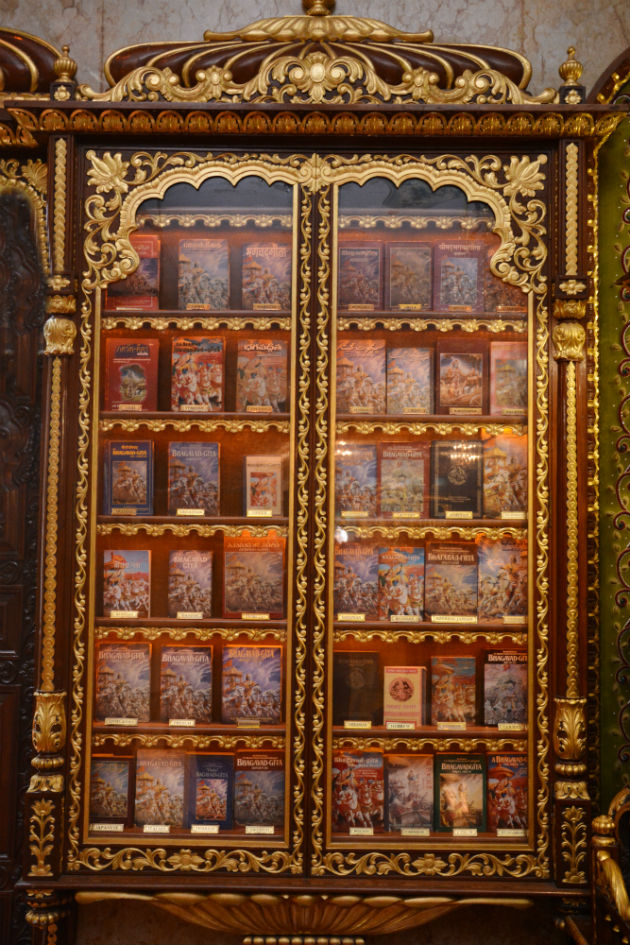
Here is the Bhagavad-Gita As It Is in many different languages, first translated from Sanskrit to English by Srila Prabhupada and published by MacMillan in New York 1967.
The Bhagavad-gita is the great crest-jewel of Indian wisdom. It was spoken 5000 years ago in Sanskrit by Krishna to Arjuna. Gita means song, and bhagavan means God. So it’s the Song of God. Its 700 verses divided into 18 chapters. In this book you will find all your core concepts - karma, yoga, reincarnation, dharma, vegetarianism, and self-realization.
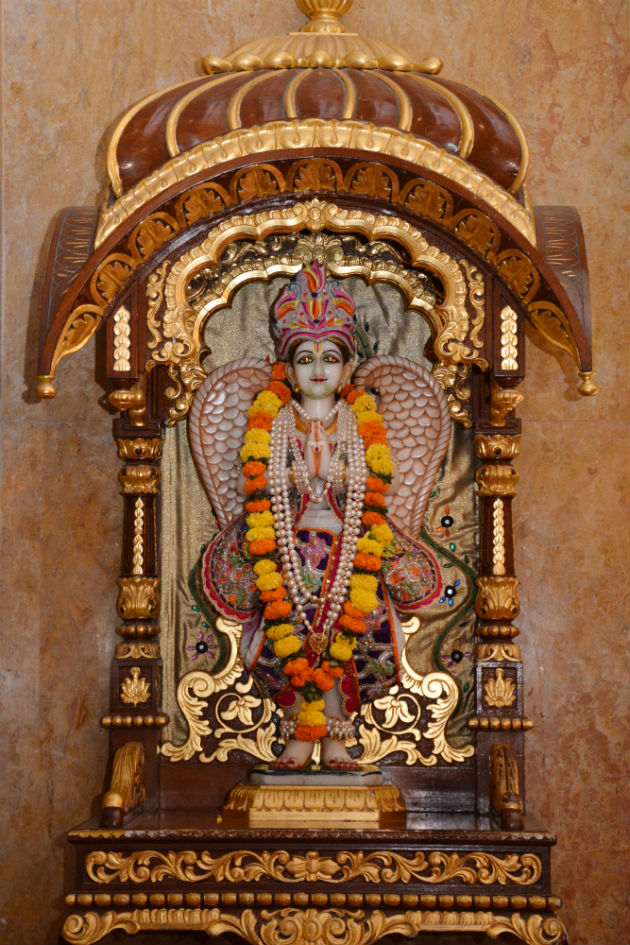
Eagle carrier of Lord Vishnu. Guardian of the temple.
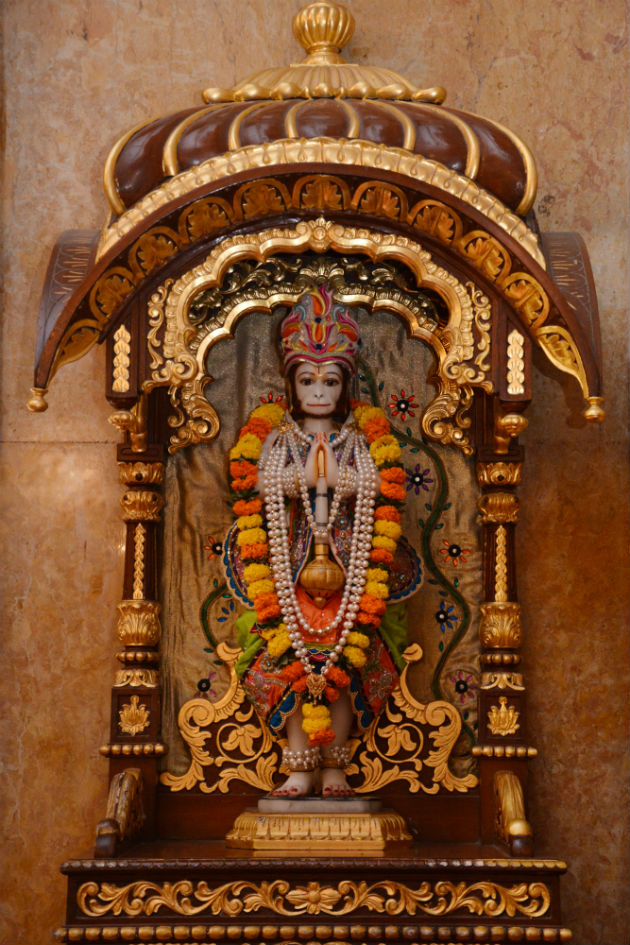
A great monkey warrior - famous all over India for his power, dedication, simplicity, and devotion to Ram (another form of Krishna). He is another guardian of the temple.
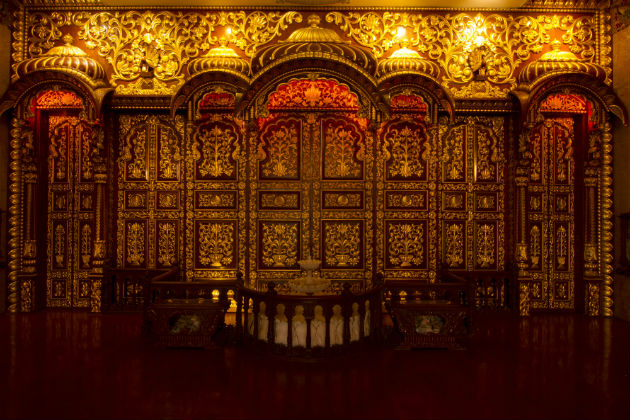
All the teak wood-work was done by Isvara & Ajit Bai Mistri and his family. It is a Haveli-designed altar (special arches and pillars) that was done by Rancor Bai Mistri just before he retired as a finale to his career. In his own words he said, “it was a miracle.” The front and back of the temple room is all 24-carat gold leaf personally handcrafted by Rancor and family. It is a very slow and tedious process. They have been working on this art for the last 4 generations and even the helpers and apprentices have been working with them for many generations. This family of artists has worked on many historical palaces and temples all over India.
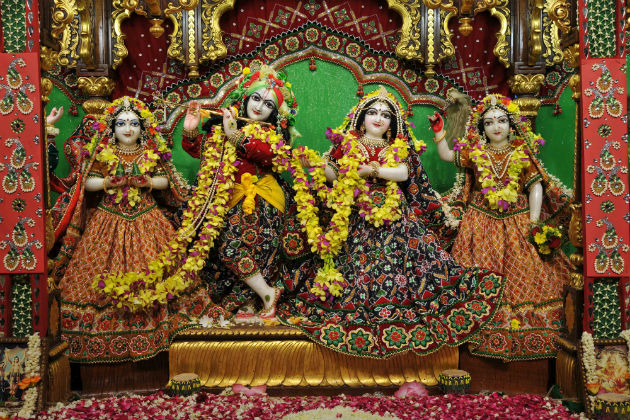
One time a German traveler was visiting different temples all over India trying to figure out who was really God. Finally, upon seeing Krishna He was satisfied that he had come to the end of his search. When asked why he thought Krishna was God he said, “when I saw other forms they were holding various weapons and instruments illustrating their involvement with the world in various ways but I see Krishna is just having a good time, holding the flute, and smiling. I realized this is God.” Just as an owner of a big company delegates management, Krishna hands over management of universal affairs to His energies. Though He is God at home, we approach Him in a formal way to facilitate spiritual growth. Another name of Krishna is Gopinath.
Beside Him is Srimati Radharani – the greatest devotee or lover of God. She is the energy, and Krishna is the energetic. Like the sunshine comes from the sun. They are inseparable.
On either side are their friends Lalita Devi and Vishaka Devi.
The Absolute Truth (God) is of such a nature that he can expand. Just like a candle can light 10 other candles, and all the subsequent candles are as powerful as the original. So those expansions are there on either side – Sri Gopal or Sri Nathji (on the right altar) and Nitai Gauranga (on the left altar).
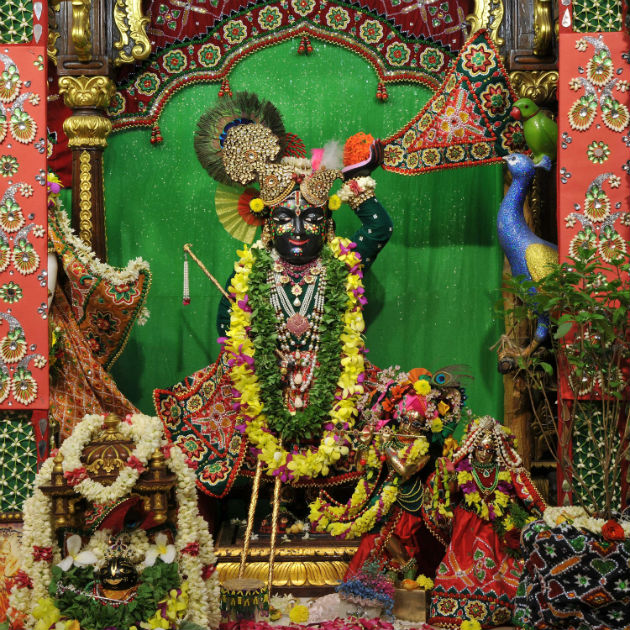
Sri Gopal means one who gives protection to the cows. It is a name Krishna received at the age of 7 when he lifted a huge mountain to protect the residents (including the cows) of His village (Vrindavan).
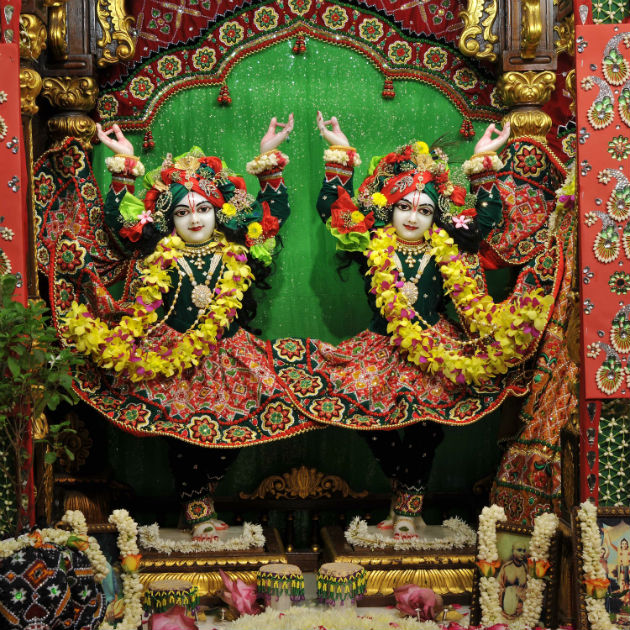
Nitai and Gauranga are brothers that appeared in West Bengal in the 1400s. Their special contribution is informing the world what is the prescribed process of self-realization for this day and age – chanting God’s names and being living examples. We see the prominence of sound vibration in all paths. The maha-mantra (Hare Krishna Hare Krishna Krishna Krishna Hare Hare Hare Rama Hare Rama Rama Rama Hare Hare) is the crème de la crème of mantras (spiritual sound vibrations), and so it is the foundation of our spiritual practices in bhakti yoga.
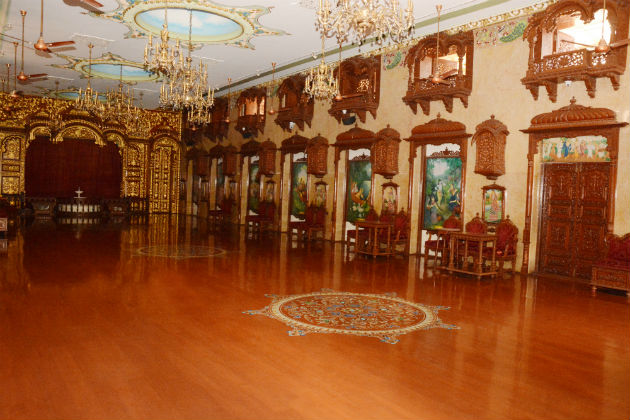
The walls are all made of Italian marble.
The tables, vyasasana, balconies, speaker boxes, the elephant heads (richness/royalty), and inside altar are all one of a kind.
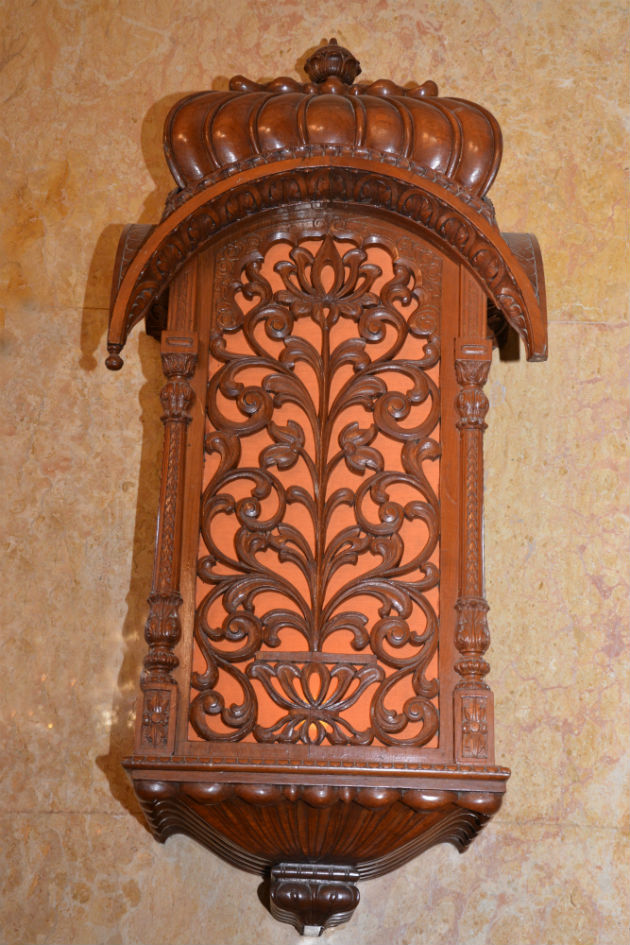
Inside these hand-carved lantern boxes are white lights covered with red velvet fabric.
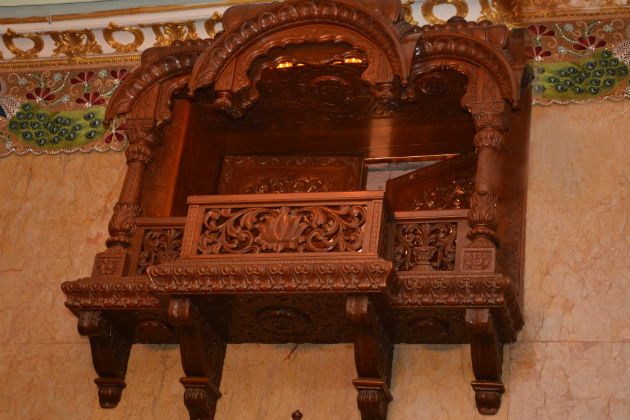
The Jharokhas or balconies were made by Isvara and Ajit Mistri. In Rajasthani and Vedic culture they were used by the women, because they would not mix freely with men.
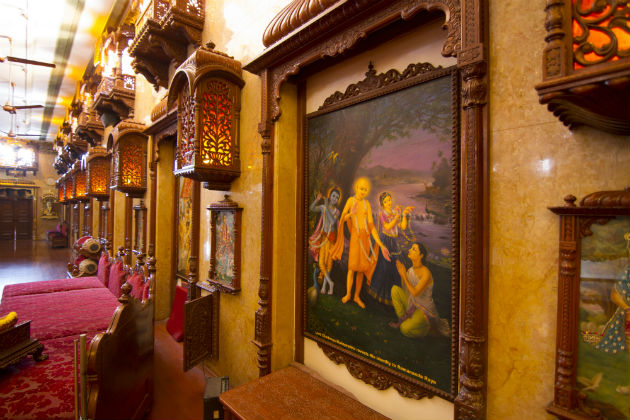
The pictures on the right side of the temple room depict various events that took place in Krsna’s early years in Vrindavan. The pictures on the left side of the temple room depict Gaura Nitai’s activities. The pictures are doorways into 2 adjacent rooms that are especially used on Sunday’s when around 3000 people come.
The umbrellas over the deities, pictures, and bookcase are called chatris. They are carved out of solid wood and are signs of respect.
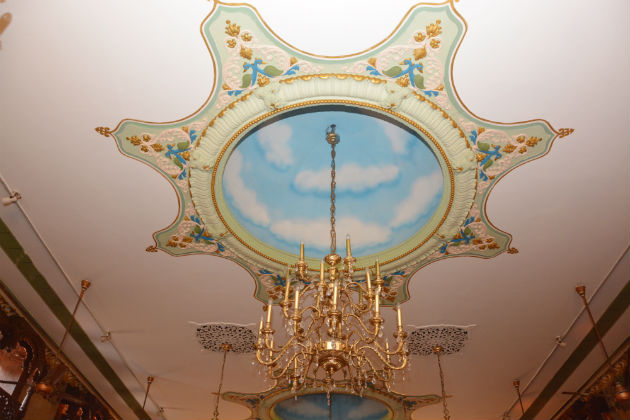
A world-renowned designer from Italy, designed the ceiling of the temple room. One of the only temples in India that has AC – our emphasis is the physical, mental, and spiritual well-being of our community.
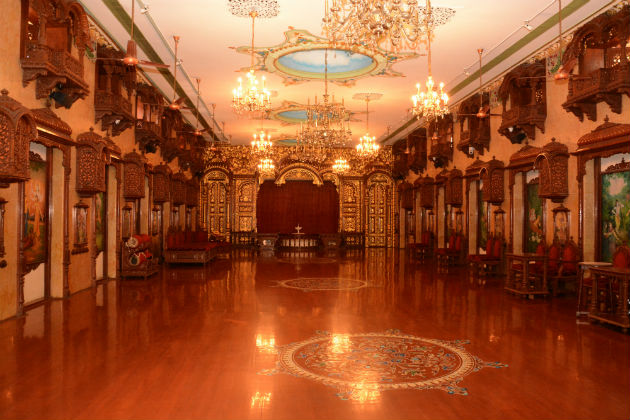
The ceiling is a unique sky-lit dome concept with beautiful floral design and glittering chandeliers that resemble the sky of Vrindavan with millions of glittering stars.
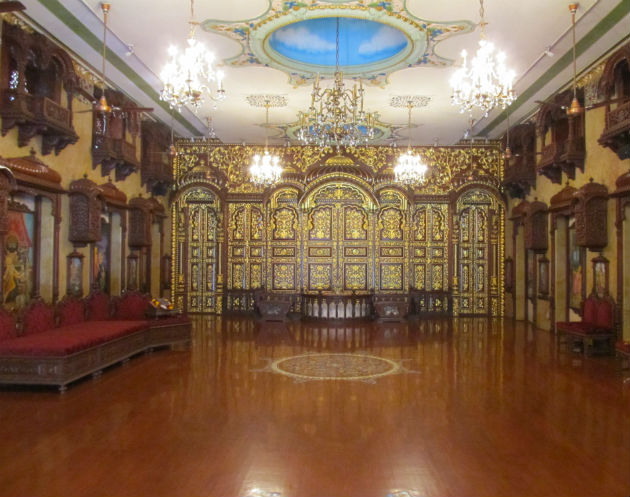
The Srimad Bhagavatam is wrapped in cloth through-out the day, except for an hour in the morning when the book is opened, read from, and discussed by a qualified speaker who sits behind the stand on the large seat (far left of picture). Sometimes many qualified speakers sit in a row on the seat to address the audience.
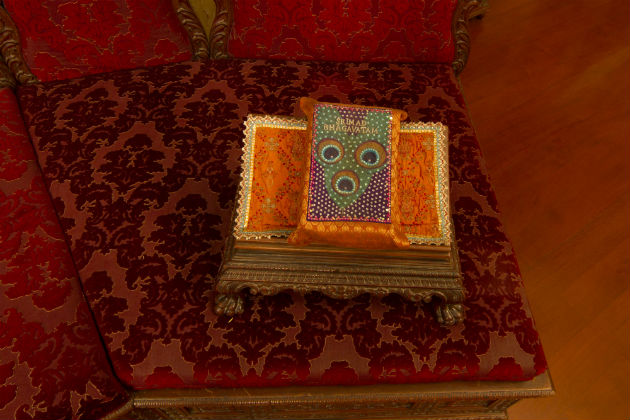
On a special hand-carved book-stand is this ancient 18 000 Sanskrit verse scripture. The knowledge within it is especially meant for enlightenment in this day and age.
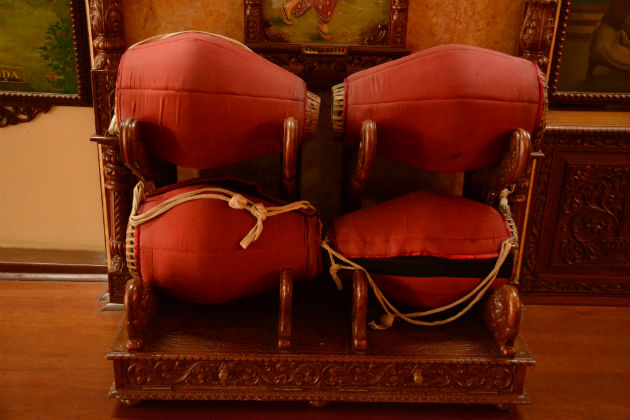
Designed and used by Gaura & Nitai in West Bengal for their kirtans (group singing of the maha mantra). They are unique because their bodies are made fully of clay, they can be carried while standing or dancing, and they never have to be tuned! Tablas (Indian classical drum) have both bass and treble facing the player, but Mridanga have both bass and treble facing away from the player – might as well be blindfolded!
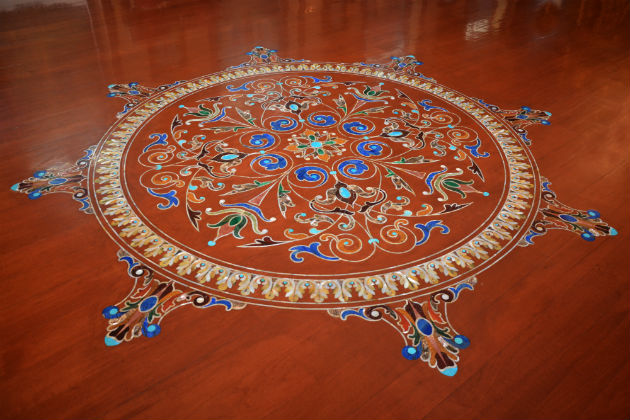
The original floor of the building was teak wood. Redone (from 1997-2008). Re-polished 4-5 times over the years. The last time it was found that the contractor had done a shoddy job (It wasn’t properly sanded). The contractor felt so bad that he said, “I will take off the finish and re-sand the floor for free.” The floor engravings are positioned directly under the domes. They were imprinted piece by piece into the wood over a period of 3 – 4 months. They are murals of 8 different kinds of precious stones and pearl.
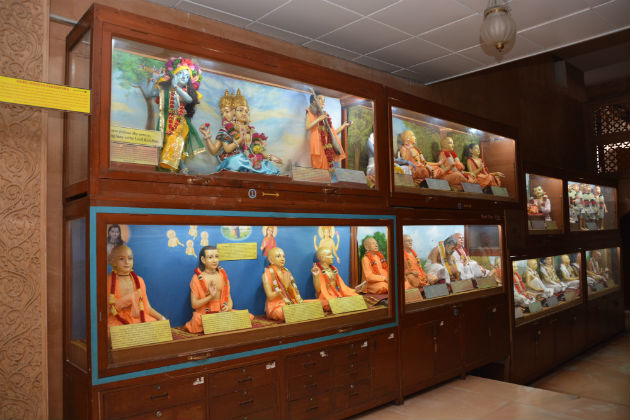
There are 3 main criteria for an authentic guru (spiritual teacher). One is that they must be pure in character, two is that he must know the scriptures (like the lawyer knows his law books) and act accordingly, and thirdly he is a student or disciple of a previous guru. One may know the law books inside and out but one still has to be an apprentice or clerk for 2 years. Vedic knowledge is carefully passed down from guru to disciple in spiritual lineages called paramparas as you see depicted here.
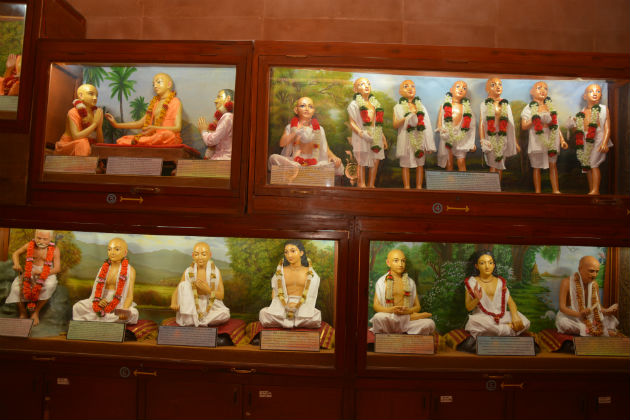
The message remains intact and unchanged as long as the connection between student and teacher is kept alive through a sincere attempt to follow the instructions of the teacher. For example Srila Prabhupada received the instruction to share the Vedic teachings in English with the rest of the world in a letter dated 1936. He gratefully and happily accepted this as his life’s mission.
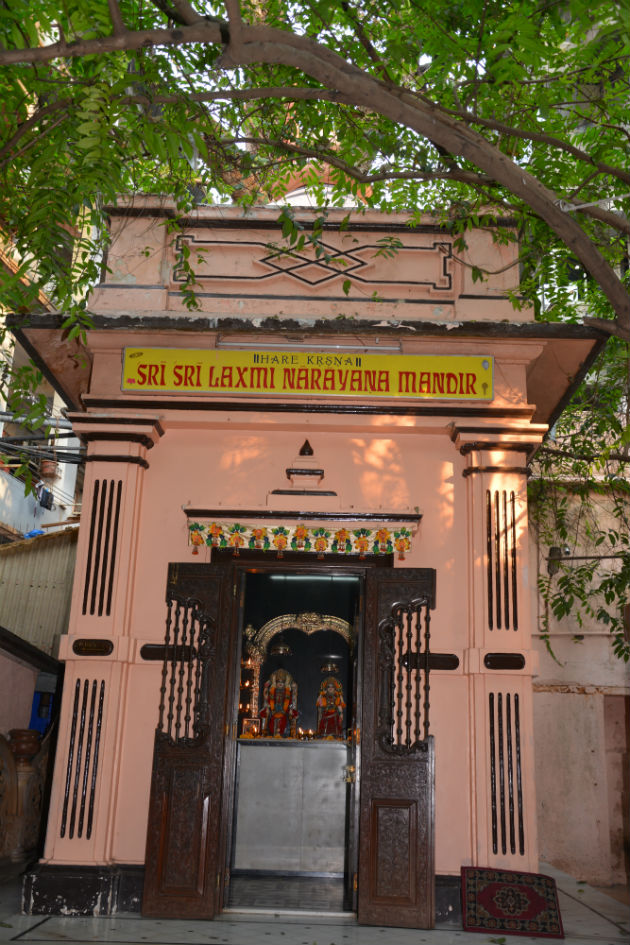
Fights amongst the children would break out and the managers of the orphanage didn’t know what to do. Then one day some boys found small clay statues of Radha and Krishna and as there was no temple on the premises they decided to place them in the hollow bark of a banyan tree which is still present behind the Lakshmi Narayan temple. Over time taking care of Radha and Krishna also filled the hollow or loneliness of loosing their parents.
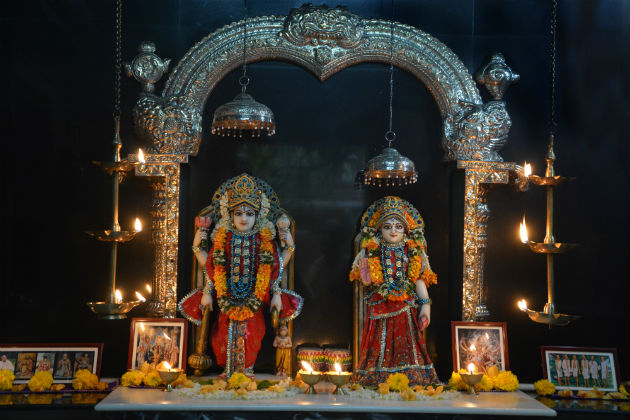
On seeing the transformation the trustees decided to build a beautiful temple for the children. In 1909 the temple was built next to the banyan tree and deities of Radha Krishna were installed. But some orthodox neighbors objected to untrained children offering puja (worship) to the deities as there was a custom of taking permission from the Vallabhacharya Sampradaya first, and they would send a Brahmin priest. So to bypass this rule the trustees decided to install the deities of Sri Laksmi Narayan who were also Radha Krishna but didn’t require a Brahmin priest to take care of them. Still many neighbors initially boycotted the temple.
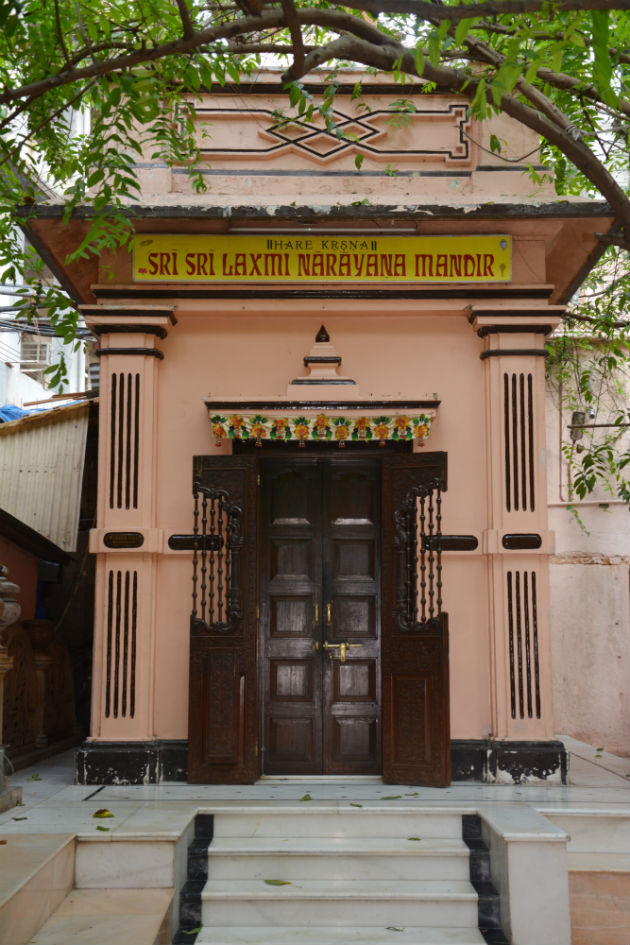
When Mahatma Gandhi, who would sometimes visit the LNHO estate for his morning prayers while staying at Mani Bhavan, came to know of the boycott he made a point to personally visit Laksmi Narayan whenever he came for his prayers. Subsequently neighbors from the surrounding areas also started coming. Gandhi is also reported to have hid from British officers who were out to arrest him by being locked inside this temple from the outside.

Buy books on philosophy, yoga, history, stories for children, biographies of saints, etc. Pictures, home-made Ayurvedic products, incense, snacks, exotic sweets, and tons more are available.
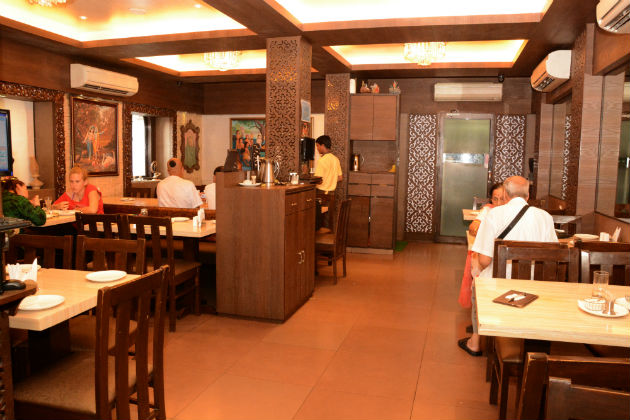
The vegetarian food served here is cooked with high standards of cleanliness and devotion. There is a wide variety to choose from. A favorite item are the pizzas – made in a traditional stone oven imported from Italy. Not a buffet!
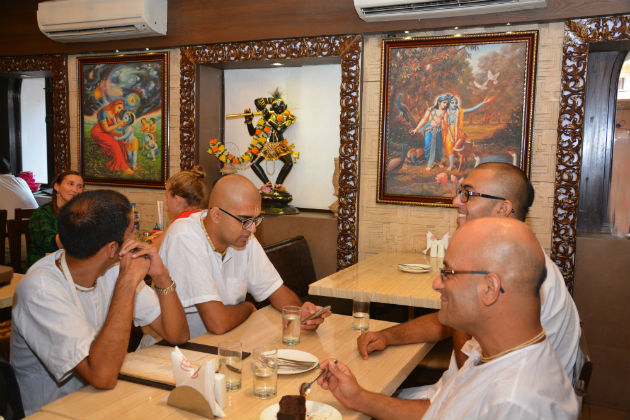
Paintings similar to the temple room.
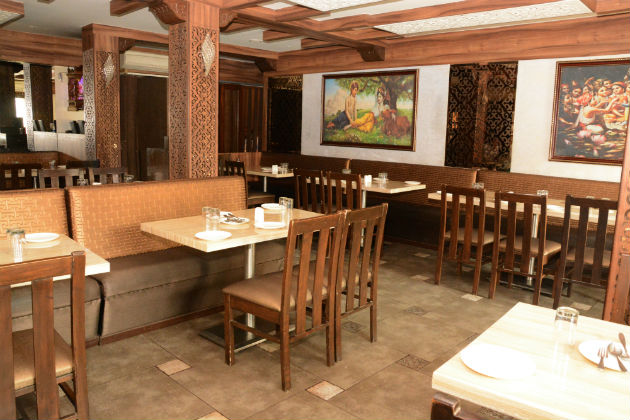
More seating up here.
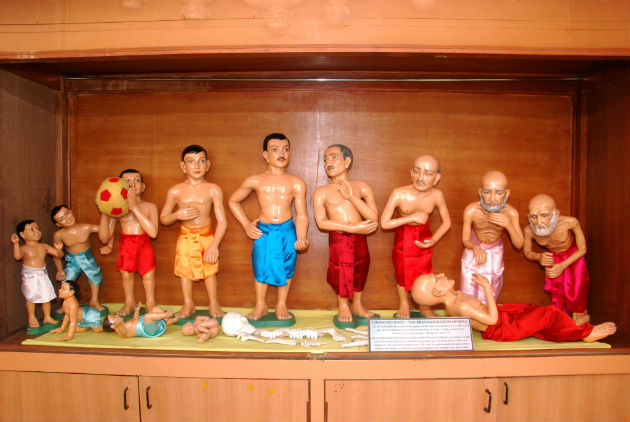
Is this one person or many different people? Yes it is one person.
Is it one body, or many different bodies? Biology informs us that every 7-12 years all the cells in our body die and are replaced by new ones. So how old can the body ever be? 12 years! So then, if our body of 15 years ago is dead and gone, and everything to do with that body is dead and gone, then why when we look at old family and school photographs do we first find where we are? Why do we identify with a body that is dead and gone? What is the constant or connecting principle behind all these changing faces and bodily characteristics? Yes, the soul.
So every 7-12 years we’re in a different body – this is what the Vedas call reincarnation (a change in body as depicted in this diorama) ‘Carne’ means body, and ‘re’ means change. So the body changes but we are still the same person.
Can I choose my next body or is it already destined? Do I (the soul) have freedom?
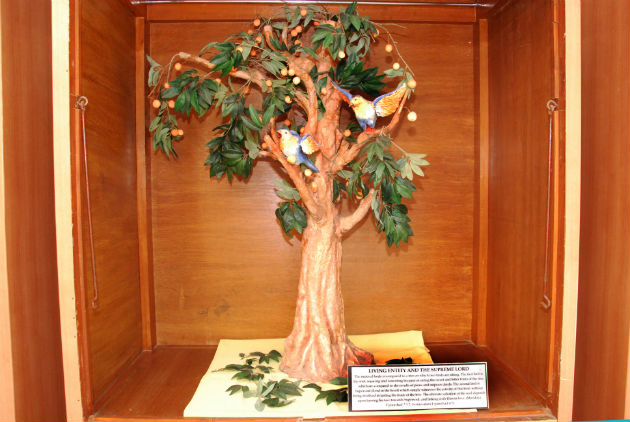
Yes. You have the freedom to desire – to infinity.
If we have material desires, we get a material body. If we have spiritual desires, we re-awaken our spiritual form. And the benefit of a spiritual form is we don’t have to come back again.
So understanding our freedom is illustrated here. One bird is us (the soul), the other bird is God in the heart. We are eating the bitter and sweet fruit of the results of our activities (tree). Our independence is in our desiring to engage in different activities. The fruits of our activities, and performing the activity itself is beyond our control. For example a lame man wants to walk but can’t. Similarly, the bird really has independence only in choosing which tree to fly to. Our material solution to bitter fruit is to fly to another tree. The spiritual solution is to just turn towards the second bird or God in the heart.
How to turn towards the other bird?
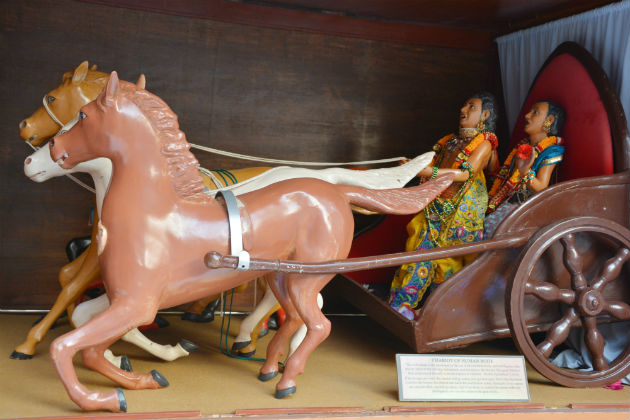
A strong intelligence; the soul is the passenger, intelligence is the driver, mind is the reins, and horses are the senses. We often just go along for the ride – letting our senses and subsequently the mind drag the chariot of the body towards sense objects. The secret of success in the journey of life is to keep the chariot on the path of developing our dormant love for God by strengthening the intelligence or driver through transcendental knowledge. The function of intelligence is to discern in situations what is right and wrong and pull the mind and senses in the right direction.
What external forces effect the mind and senses?
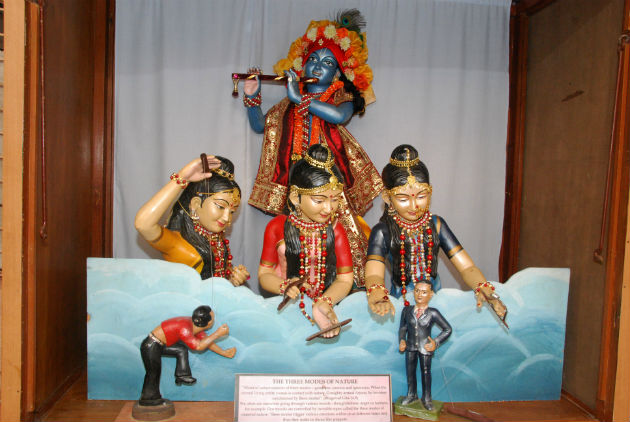
The three modes of material nature: goodness, passion, and ignorance. Bhagavad-Gita (17.16) describes bringing the mind onto the platform of goodness by cultivating satisfaction, simplicity, gravity, self-control, and purification of one’s existence.
Where do I start – How to be satisfied in mind? “The mind should be so trained that it can be always thinking of doing good for others.” (BG 17.16)
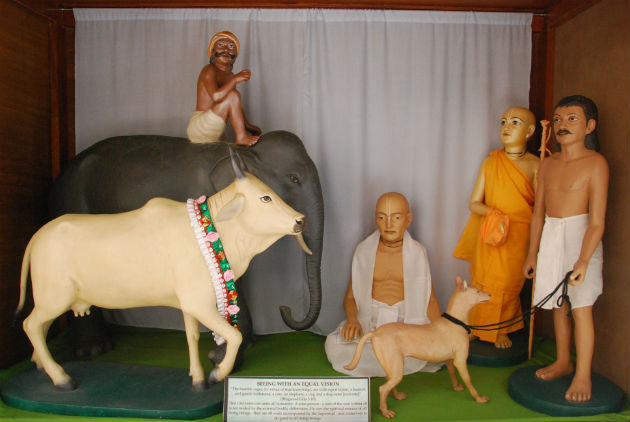
‘But such and such doesn’t deserve it – he is poor, white, black, male, female, young, old, rich, poor, etc.’ The way to destroy this mentality is to see that we are all equal on a spiritual level. Not just humans, but animals, and plants too – all living beings. This comes about by vidya (true knowledge) and vinaya (humility).
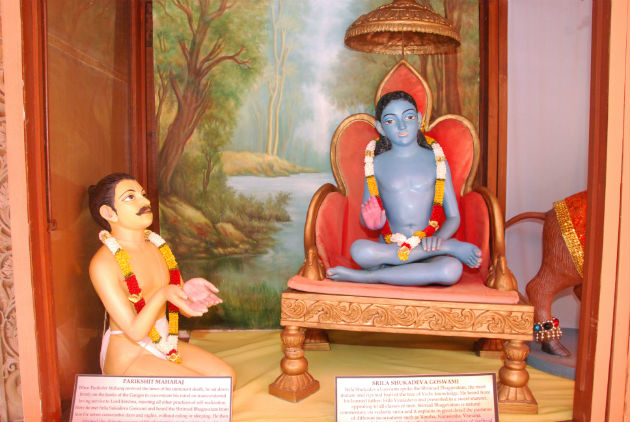
Srimad Bhagavatam was compiled by Srila Vyasadeva in Sanskrit over 5000 years ago. It was centered around a spiritual discussion between his son Sukadev Goswami, a self-realized soul, and King Pariksit, who had 7 days to live and wanted self-realization. Srimad Bhagavatam contains all of what you see displayed in these dioramas, and scientifically brings the sincere reader to self-realization.
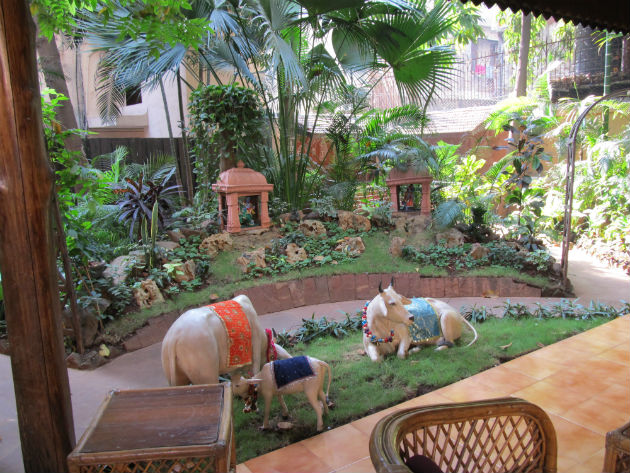
The garden is inspired by a village 144 km south of Delhi on the way to the Taj Mahal called Vrindavan (forest of Holy Basil or Tulsi). Vrindavan is where Krsna appeared 5000 years ago. Summed up in 2 words: concentrated spirituality. Walk around over 5000 temples in 2 hours!

6 renunciants called the Goswamis restored Vrindavan in the 1500s. The first 2 temples they built were Govindaji (diorama) and Madan Mohan (diorama above waterfall). On the pond is Krishna dancing on Kaliya.
